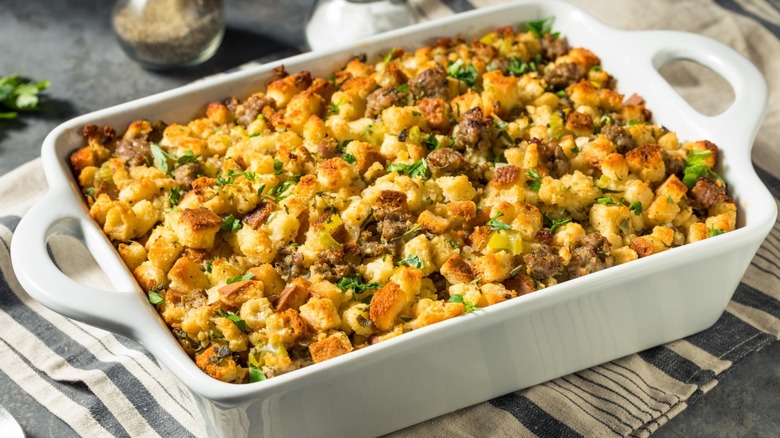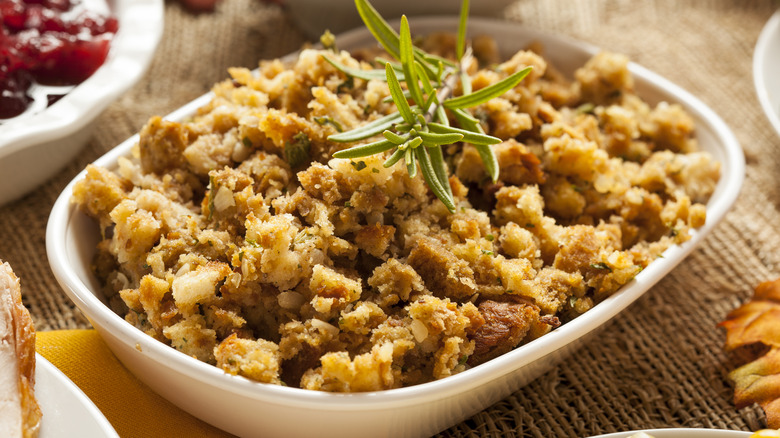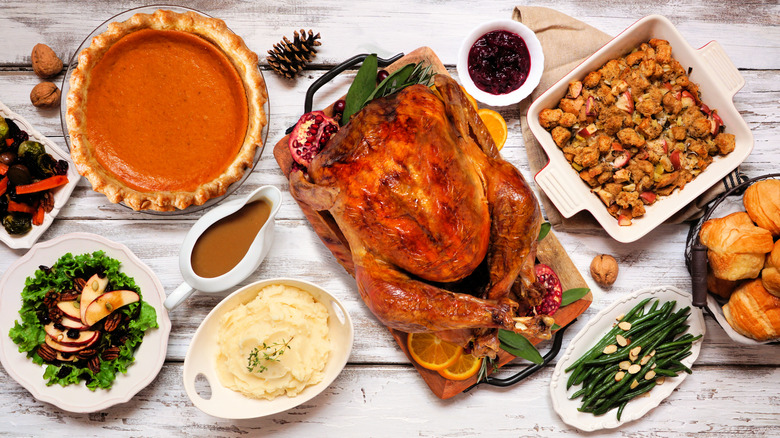How To Avoid Too Much Salt In Stuffing
Essentially a savory bread pudding, stuffing (or dressing, depending on personal/regional preferences, per Southern Living) is a cultural standby, especially on holidays. While recipes differ from family to family and household to household, there are some non-negotiable ingredients.
At its core, stuffing is made with bread, whether that be stale cubes of sourdough, pulled-apart white bread, or cornbread crumbles. There is no rule in terms of what bread should be used, so feel free to get creative. From there, vegetables have a starring role, usually focused on alliums (leeks, onions, shallots), celery, garlic, or even root vegetables. There is also a liquid component — typically milk, broth, or stock — as well as some eggs. Beyond this, you are free to throw in anything you desire, from walnuts or sage to apple cider, oysters, or sweet Italian sausage. The whole shebang is thrown in the oven and the end result should be deeply browned, incredibly crispy on the outside, and soft, supple, and tender within. You can't beat a well-made stuffing, no matter if it's made inside the turkey or separately cooked in a sheet tray or casserole dish. Though if you do go the stuffing-inside-the-turkey route, be forewarned that it can be dangerous, according to Self.
For some, however, spicing and flavoring can be a challenge when it comes to stuffing cookery. Luckily, there are some tips on how to perfect your seasoning's salt levels and ensure that all of your guests are positively enamored of your stuffing iteration.
What are the best tips for removing salt?
One popular ingredient is Bell's Seasoning, a retro spice blend that includes rosemary, oregano, sage, ginger, marjoram, thyme, and pepper. Many people also use stock to moisten the bread mixture before baking. Stocks are typically loaded with sodium, so one idea is to buy low-sodium or even sodium-free variations of stock and broth to help you better dictate the salt quotient. If you're foregoing stock/broth and only using milk, don't fret about the salt content.
Making stuffing is a practice of 'layered cooking,' in that you must prepare various components separately before combining them and throwing the whole shebang into the oven. Ensure that you are properly and evenly seasoning each component, tasting and adjusting as you go. If you try to only season at the end, you may wind up with a real salt lick (per Salt Sear Savor).
SheKnows recommends adding some water, which should dilute the flavor to combat the saltiness. Other options are adding some sort of sweetness, acid, or adding dairy: cream does a great job at nullifying salt. Fats in general are good at 'battling' saltiness. WebstaurantStore notes that "veggies with little flavor of their own will absorb some of the flavor that exists in the dish," so adding more vegetables to your stuffing may be another way to reduce the salty flavor. Greens do the same thing, so maybe throw some kale or spinach into your stuffing, which will also add color.
Perfecting your seasoning skills
EatingWell also acknowledges this issue, noting that certain go-to stuffing ingredients are unfortunately packed with sodium, including bread, sausage, and broth. The publication notes being "judicious" with those salty ingredients, and also tasting before adding any extraneous spice or herb blends. The natural salt inherent in many of the ingredients may have already adequately seasoned the mixture prior to your adding more and baking so be sure to double-check before adding any additional salt. eHow notes that "it is easier to add seasoning to a bland stuffing than it is to correct an overseasoned stuffing," which is a great cooking lesson overall. Their recommendation is to add other ingredients — such as bulking up your recipe with extra bread to help diffuse the salt amount — or even "using temperature to change how the eater perceives the flavor." Interesting!
Best of luck with your salt escapades this Holiday seasoning! A little bit of tweaking and tasting along the way can help to ensure the most wonderfully flavored dish. This applies not just to stuffing, but to the turkey itself, and even dessert. Holiday cookery is a wonderful vehicle to help you perfect your kitchen skills.


